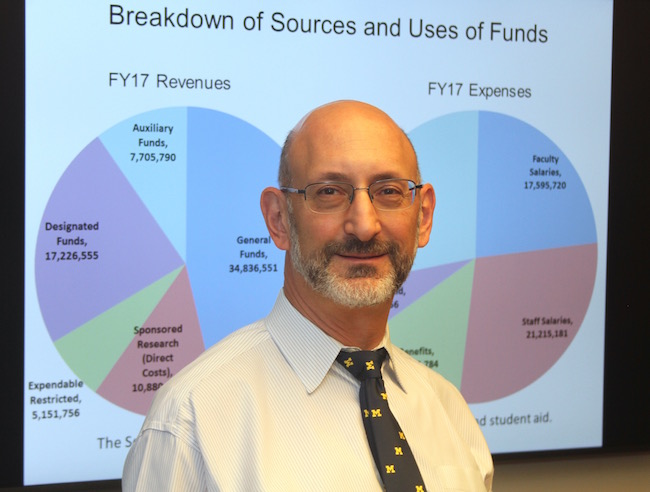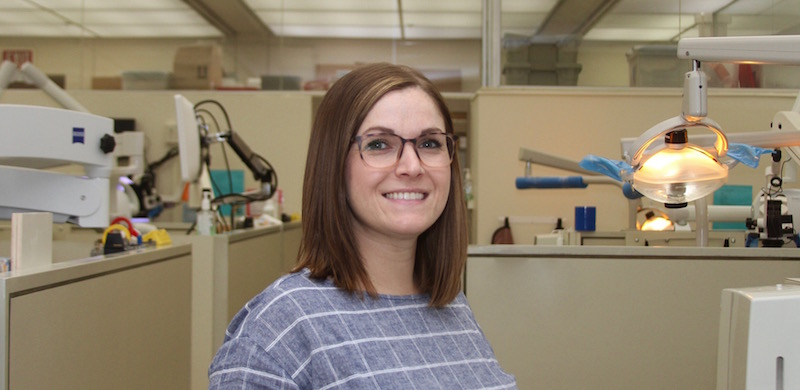Strategic Plan Update7 min read
Responsible Growth and Sustainability domain
One in a series of updates on the five domains within the School of Dentistry’s ongoing Strategic Plan.
Ann Arbor, Mich., Nov. 28, 2018 — Improving the financial viability of an $85 million enterprise, while planning strategically for its continuous advancement, requires a comprehensive commitment across all departments. That’s the ongoing challenge being met by leaders of the Responsible Growth and Sustainability Domain in the School of Dentistry’s ongoing Strategic Plan.

The Responsible Growth and Sustainability Domain, one of five domains in the Strategic Plan, focuses on the school’s budget. Domain leaders and staffers throughout the school are exploring ways to expand revenue and decrease expenses while continuing to meet and improve upon the school’s mission of advancing health through education, service, research and discovery.
Domain leaders Michael Fox, Director of Budget and Financial Planning, Jacques Nör, chair of the Department of Cariology, Restorative Sciences and Endodontics, and Ashton Steele, Associate Director, Corporate and Foundation Relations, oversee an evolving slate of actions, goals and success measures. The initiative can be described as: Identify a problem, find a solution.
Goals for clinic operations have been set by clinics over the past few years. Domain leaders generated a set of so-called “critical conversations” to guide the improvement effort. Examining clinic operations, for example, led to questions such as how to reduce the number of patients who don’t show up for appointments; how to encourage and follow through on internal patient referrals between clinics to best serve our patients; and how to minimize the inefficient use of supplies by encouraging best practices. Four of the six clinics met their goals for Fiscal Year 2018.

The Graduate Endodontics Clinic in the Department of Cariology, Restorative Sciences and Endodontics provides a case study in how re-examining existing practices can yield savings and improvements. Andrea Morefield, clinic coordinator, said she worked with Nör, the department chair, and Neville McDonald, Director of the Endodontics Division, to compile a report on “chair utilization.”
The question was whether graduate residents who treat patients were being scheduled as efficiently as possible around their classroom time and other commitments. By more closely monitoring the residents’ schedules, the department found that it could fill more open time slots with patients for the clinic’s eight dental chairs. That meant more patients, improved care and more revenue coming into the department. Another part of the solution was making sure the length of time allocated for a patient appointment matched the type of treatment being performed for the patient; previously, appointments often were blocked out for longer time periods than necessary.
“If residents are not in class, the idea was: Can we add them into clinic to give them more experience, give them more hands-on time with patients?” Morefield said. “We increased our chair utilization by running that report and finding, yes, we do have open areas where we can schedule the residents because they are not in class. It improved our production.” The percent of chairs in use increased from 64 percent in 2015 to 77 percent in 2017.
In addition to generating more revenue by being able to treat more patients, the Endo clinic also showed improvement in cutting costs. “We figured out what we could replace without jeopardizing patient care or experience for the resident,” Morefield said. “It’s based on the products we use, so we went through the companies to see if we could get a better price from another company. That helped out tremendously.” For example, she said the clinic examined the cost of hand files, a tool the clinic depends on for root canals, which are its main procedure. Morefield contacted an alternative supplier that beat the cost of the existing supplier by more than half. “It saved us a lot because hand files are single-use and we go through hundreds of them in a month,” Morefield said. Another cost savings came in dealing with new suppliers for larger pieces of equipment as well, rather than ordering from the same supplier as in the past. As a result of better scheduling and cost-savings, the Endo clinic made its goals for financial improvement two years in a row.
Fox said another small but important example of improving financial processes came from researching how to electronically link two accounting software programs so that information from one could be fed directly to the other to produce an important report. Under the previous method, data from one report had to be manually entered to the other program. By eliminating that step and linking the programs electronically, Fox said, staff is freed up to focus on work closer to the mission of the school.
“We want to have more resources go directly to teaching and learning – any way we can do that,” Fox said. “That is our passion, that is our vision and mission. Every opportunity we have to identify tasks that we no longer need means it frees us up to focus on teaching and learning. Then we can constantly ask: What else can we stop doing so that we only add value to things that help our faculty and students? That’s our goal.”
Here are some improvements that are either already implemented or are in progress:
- Transparency. In the often-complex area of budget numbers that many non-accounting employees find confusing, domain leaders have emphasized transparency as a key to making progress in this domain. The overall budget, along with highlights from research and clinic activity, is posted online for the current and previous two years. The budget presentations list not only the black-and-white numbers, but also explain trend lines for revenues, spending, enrollment, tuition and other categories. The posting uses a “dashboard” summary with traffic signal graphics indicating when targets are reached (green light), a bit behind (yellow light) or significantly under targets (red light). Pre- and post-surveys of the new online reporting showed that key stakeholders reported a 17 percent improved understanding of the overall and clinical financial status.
- Benefits of the building renovation. The upcoming major building renovation at the School of Dentistry, called Blue Renew, provides many opportunities for improved efficiencies. From improved electronic medical records to re-imagined operatory configurations and furnishings, the renovated school will help students, faculty, patients and staff operate more efficiently. Even the way patients arrive at newly designed entrances and check-in areas will streamline their experience. By centralizing the clinics’ front desk and reception areas, the school anticipates a savings in staff positions. New and more efficient mechanical, electrical and plumbing systems are expected to cut utility costs by 5 percent.
- Elsewhere throughout the domain: Fox notes that the school’s endowment and discretionary funds continue to be strengths, growing significantly and allowing for better planning and flexibility. A process was identified to match sources of funds with the needs identified in the next five years to replace existing assets. To deal with write-offs on insurance accounts that were above targeted levels, the Clinic Billing Office engaged with other departments around the school to coordinate improved practices; the level of accounts receivable has fallen significantly even as the volume of charges has risen, an indication that the teamwork across the school is paying off.
- The next five years will provide many opportunities and challenges for the Responsible Growth and Sustainability Domain as the school completes Blue Renew. Part of that project is a complete rebuild of the predoctoral clinics while remaining in the current facility. Work has already started to lessen the potential impact on patient care and the potentially negative impact Blue Renew might have on clinic income. A positive opportunity with Blue Renew is a new research complex designed to foster a collaborative approach that stimulates the development of new ideas and allows for efficient and cooperative use of new technologies. Financial efficiencies will include automating a manual posting system for the large volume of patient payments made online. The school also is working with other Big Ten dental schools to develop a common financial dashboard that will allow an improved comparative analysis for key financial benchmarks that will benefit all the schools.
Visit the School of Dentistry Strategic Plan website for more information.
